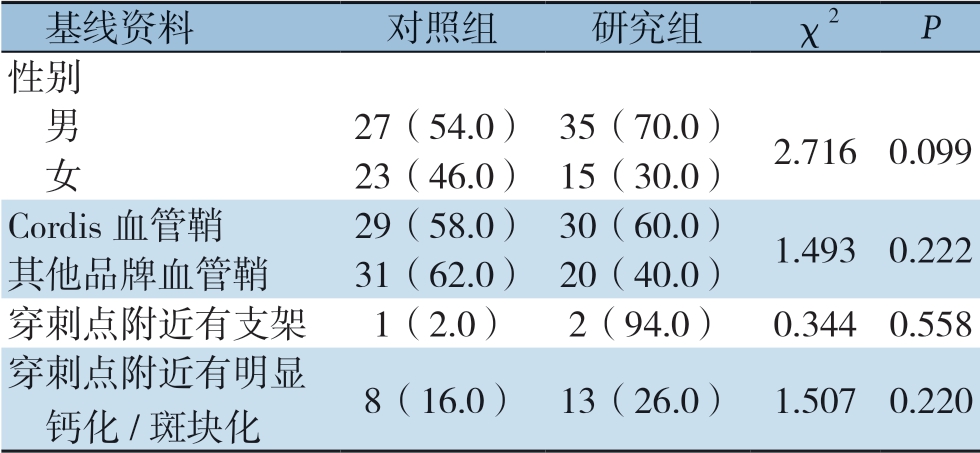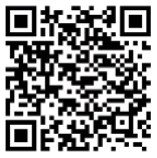随着血管介入技术的发展,介入手术已经成为血管外科的主要治疗手段[1]。与手术直接相关的股动脉穿刺点处理成为手术操作收尾的一个重要环节。临床上对于股动脉穿刺鞘在6 F及以上的情况,通常会选择封堵穿刺点。大量研究证实ExoSealTM封堵止血系统(Cordis公司,美国)因其操作简便、患者舒适感好,止血效果明确、并发症少[2],越来越得到血管介入医生的欢迎。对于该系统的新使用者,以往的教学培训方法是阅读使用说明书和观看操作视频,因此操作者得到的是理论和间接经验。对于手术操作训练,需要脑、眼、手的配合,当代的模拟方法为团队合作、沟通技巧和专业精神的教学引入了新的理念[3],已被用于医学训练,以促进外科和微创技术的学习[4]。因此本研究将ExoSealTM封堵止血系统的模拟器用于介入医师的培训,用以探讨使用模拟器的培训模式在临床操作中是否具有优势。
1 资料与方法
1.1 培训对象
选取2020年5月—2020年10月7个中心(中国人民解放军总医院第一医学中心,天津医院,中国人民解放军总医院第六医学中心,河北中石油中心医院,天津市第一中心医院、北京市垂杨柳医院、 石家庄市第三医院)的8 名介入医师为培训对象,6 名高级职称医师和2 名中级职称医师,均为男性,年龄为(39.88±3.80)岁,操作年限为(10.63±4.47)年。6 名高级职称医师和2 名中级职称医师分别随机分到对照组和研究组,每组均由3 名高级职称医师和1名中级职称医师组成。比较两组医师年龄[(40.25±5.68)岁vs.(40.25±3.77)岁,P=1.000]、操作年限[(11.00±6.00)年vs.(13.25±5.32)年,P=0.595],差异均无统计学意义。每组医师对50例患者实施股动脉封堵操作,共有100例患者,其基线资料比较差异均无统计学意义(P>0.05)(表1),组间具有可比性。
表1 两组操作患者的基线资料比较[n=50,n(%)]
Table 1 Comparison of baseline data of operated patients between the two groups[n=50,n(%)]

基线资料对照组研究组χ2P性别男27(54.0) 35(70.0) 2.7160.099女23(46.0) 15(30.0)Cordis 血管鞘29(58.0) 30(60.0) 1.4930.222其他品牌血管鞘31(62.0) 20(40.0)穿刺点附近有支架1(2.0) 2(94.0) 0.3440.558穿刺点附近有明显钙化/斑块化8(16.0) 13(26.0) 1.5070.220
1.2 研究方法
本研究实施了两组培训比照,将8名医师随机分为对照组和研究组,所有医师都有介入相关手术经验,其中4名阅读ExoSealTM说明书和观看视频(对照组),4名在前者基础上增加专业人员指导下的模拟器练习(研究组)。研究方案由文章通信作者设计并实施教学。
ExoSealTM封堵止血系统(图1)是由前端的合成聚乙醇酸的封堵插塞和释放系统组成,通过释放前端合成的聚乙醇酸插塞至股动脉穿刺点上方而发挥其止血作用。合成聚乙醇酸是一种生物可降解物质,自然水解后降解为CO2和水,30 d内大部分吸收,60~90 d内可完全吸收。模拟器(图2)是由亚克力材质制成,匹配血管鞘后可模拟血管介入手术中动脉置鞘状态的操作模型。

图1 ExoSealTM封堵止血系统示意图
Figure 1 Schematic diagram of ExoSealTM vascular closure device

图2 模拟器实物图 A:模拟器正位;B:模拟器侧位;C:模拟器上位
Figure 2 Actual figure of the simulator A:Anteroposterior view;B:Lateral view;C:Top view
1.3 教学实施
上述8名医师都得到了ExoSealTM封堵止血系统理论知识的培训和操作视频的培训,其中研究组另外还得到了ExoSealTM封堵止血系统模拟器的训练。
1.3.1 对照组的教学过程 对照组的教学中,使用了Cordis 公司提供的标准化ExoSealTM封堵止血系统的结构、部件,以及操作原理的中文文字说明,并且详细描述了该系统使用的适应证、禁忌证,规格的选择,操作成功的判断标准,操作不成功的判断标准,各种并发症的成因。
1.3.2 研究组的教学过程 研究组的教学中,除了使用对照组的理论知识文字配合和操作视频培训外,还专门安排1 名Cordis 公司的培训师,来指导每1 名受训者在模拟器上的操作。该操作使用股动脉模型的管壁厚度和股动脉近似,使用的穿刺鞘均为6 F 的短鞘,受训者的操作的每一个步骤,都在培训师的指令下完成。
1.4 培训效果评价
在此后的临床介入操作中,研究组和对照组的受训医师,每人均使用ExoSealTM封堵止血系统,完成股动脉顺行和逆行置入的6 F短鞘封堵。记录封堵操作所需时间、出血量、器械成功率、动脉栓塞发生率、住院期间二次干预率。出血量的测算方法是用放于封堵器回血指示器一侧的手术弯盘收集喷出的血液,注射器计量出血量。封堵失败定义为无法按下插塞展开按钮、封堵后插塞从穿刺点脱落,或者封堵后穿刺点有血液涌出。
1.5 统计学处理
采用SPSS 25.0分析数据。对照组及研究组操作所需时间、出血量为计量资料,符合正态分布,则采用均数±标准差( ±s)表示,组间比较用t检验;不符合正态分布,则采用中位数(四分位数间距)表示,组间比较用Mann-Whitney U检验。均为双侧检验,检验水准α=0.05;器械成功率、术后24 h血肿发生率、动脉栓塞发生率、住院期间二次干预率为计数资料,采用率表示,组间比较用χ2检验或者Fisher确切概率法检验,检验水准α=0.05。
±s)表示,组间比较用t检验;不符合正态分布,则采用中位数(四分位数间距)表示,组间比较用Mann-Whitney U检验。均为双侧检验,检验水准α=0.05;器械成功率、术后24 h血肿发生率、动脉栓塞发生率、住院期间二次干预率为计数资料,采用率表示,组间比较用χ2检验或者Fisher确切概率法检验,检验水准α=0.05。
2 结果
2.1 操作时间和出血量的比较
对照组操作时间是30.00(20.00~45.00)s,研究组操作时间是24.50(15.00~35.00)s,差异有统计学意义(P=0.003)。对照组平均出血量是11.22 mL,研究组平均出血量8.60 mL,差异有统计学意义(P=0.019)。表明研究组在操作时间和出血量上明显优于对照组(表2)。
2.2 封堵效果和并发症的比较
对照组封堵失败2例(4%),1例一直未出现指示窗变色,再继续操作封堵器全部退出,行手动压迫;1例是封堵器退出时角度偏小。研究组封堵失败1例(2%),原因是封堵最后一步未能完全释放插塞,拔出时发现插塞仍在封堵器输送杆上。研究组器械成功率与对照组器械成功率的差异无统计学意义(P=0.558)。两组均未发生术后动脉栓塞事件、二次干预事件和24 h内发生血肿事件(表2)。
表2 两组操作指标和效果的比较
Table 2 Comparison of operative and effect variables between the two groups

操作和效果指标对照组(n=50)研究组(n=50)P操作所需时间(min,images/BZ_24_1735_1043_1762_1084.png±s)33.50±14.9926.20±11.950.003出血量(mL,images/BZ_24_1735_1043_1762_1084.png±s)11.22±5.618.60±5.320.019器械成功率(%)96.0(2/50)98.0(1/50)0.558动脉栓塞发生率(%)001.000住院期间二次干预率(%)001.00024 h 内发生血肿率(%)001.000
3 讨论
3.1 新器材传统培训模式的缺陷
外科是一门讲究实践操作的专业,外科医生几乎每天都面临着具体的操作,而操作成功与否、顺利与否,不仅决定患者治疗的成功率,也决定了各种并发症的发生率[5]。上述两点,也是评价外科医生水平的一个非常重要的指标。以往外科医生的操作学习,源自几个部分循序渐进,首先是理论学习,其次是操作视频学习,然后是在病例实践中作为助手,最终在有经验医生指导下实施操作[6]。通常来说,新手的手术操作会遵循上述步骤。由于血管解剖的复杂性,导致对于初学者很难透彻理解其中的重点和难点。另一个重要的技能培训方向是对血管外科微创治疗的理解和掌握,是技能培训教学体系的一个薄弱点和难点[7]。动脉封堵器的使用,可以归类于临床操作中的小型手术,步骤不多。但是由于新器材往往缺乏操作的传承性,从而导致可指导的有经验医生不足。同时这类器材的另一个特征,是对操作的每一个步骤准确性要求较高,每一个操作步骤的成功才能决定结局的成功。所以传统的操作教学模式在此类新器材的培训上就缺了后面的两个阶段,导致操作培训就简化为理论学习和操作视频学习。尽管有经验的医生基于前两个阶段的学习,基本上能熟悉封堵器的使用,但是不容易较快度过学习曲线。虽然我们看到了本研究中只有理论和视频学习的医生也得到了较好的操作成功率和零并发症发生率,并且对于操作失败有后续的补救措施。但是对于任何一个有创操作,医患双方都希望得到最佳结果。如果有机会减少出血量,以及提高器材成功率,就值得改进培训方式。
3.2 封堵止血系统模拟器培训的优势
应用活体动物训练是最为接近临床实际操作的练习模式[8],但是随着饲养成本提高,场地受限,以及伦理学等问题的出现,使用活体动物进行训练逐渐受到限制[9],也有人主张使用新鲜冷冻尸体对血管外科医生进行培训[10],但同样存在成本等问题。近十几年来,欧美学者在医学操作培训方面,越来越重视模拟训练[11-14]。尤其是模拟系统的使用,其中心肺复苏急救模拟系统[15],腔镜模拟系统[16],虚拟介入手术模拟系统[17]已经被医学界应用到技能培训中。在医学生和专科医生的培训中,这些模拟系统的应用可以显著提高初级外科医师的手术技能[18]。封堵止血系统模拟器培训的优势主要在于:⑴封堵止血系统模拟器培训让新手快速建立操作时的手、眼、脑的协调性,任何操作都需要手、眼、脑的协调,尤其对于复杂操作,这种协调性要求更高[19],而单纯理论学习和视频学习,只刺激了脑和眼,无法带动三个器官的配合。⑵封堵止血系统模拟器培训让新手记住操作的流程和各种非量化手法。操作的掌握程度很大程度上无法量化,操作者必须通过重复训练,在实践中感受和记忆,才能提高操作水平[20-21]。因此使用模拟器训练,可以让操作者在大脑内形成操作的非量化的记忆,有的细节甚至形成条件反射,为更早建立学习曲线带来很好的条件,平稳度过学习曲线[22-23]。而ExoSealTM操作步骤少,无需换鞘,学习曲线短。其释放快捷,安全性风险低,大量临床试验证明,对比人工压迫,使用血管封堵装置可以显著缩短止血时间[24-26]。且ExoSealTM插塞由生物可吸收材料聚乙醇酸构成,30 d内大部分吸收,60~90 d内完全吸收,插塞降解为二氧化碳和水,不影响重复穿刺[27]。
本研究的两组操作中,使用模拟器的研究组在封堵操作时间和出血量方面,明显优于对照组(P=0.003,P=0.019)。更进一步强化了模拟器训练操作的优势。尽管本研究所得出的结果中,平均操作缩短时间和平均出血量减少的数值不是很大,但是医师通过模拟器训练在术前体会封堵止血系统操作过程,增加经验[28],有利于提高封堵止血系统操作的信心[29],优化操作过程,减少严重错误的发生[30],对减少患者术中和术后并发症,以及加快患者的恢复都有重要的临床意义[31-32]。这从另一个方面也正说明了模拟器训练的必要性。目前临床技能训练课程存在设置分散、教学模式单一、动手机会少等缺陷,限制了临床技能教学的效果[33]。我们建议在临床积极开展模拟器培训课程,制定标准教材和流程,使得该课程的教学更规范、质量更高。且随着培训时间的延长,医师操作技能得到持续提升[34],操作时间更短,出血量更少。因此我们应当对模拟器培训引起足够的重视,才有可能把模拟器的优势发挥到最大。
总之,目前外科操作模拟器的使用,在临床教学方面的价值越来越显而易见,实践操作培训结合理论和视频教学的方法,有望能成为今后外科操作教学的主流方式。
[1]史振宇,符伟国.中国血管外科的现状和展望[J].上海医学,2017,40(3):135-138.
Shi ZY,Fu WG.Current state and perspectives of vascular surgery in China[J].Shanghai Medical Journal,2017,40(3):135-138.
[2]Hackl G,Gary T,Belaj K,et al.Exoseal for puncture site closure after antegrade procedures in peripheral arterial disease patients[J].Diagn Interv Radiol,2014,20(5):426-431.doi:10.5152/dir.2014.14002.
[3]Evgeniou E,Loizou P.Simulation-based surgical education[J].ANZ J Surg,2013,83(9):619-623.doi:10.1111/j.1445-2197.2012.06315.x.
[4]Young MN,Markley R,Leo T,et al.Effects of Advanced Cardiac Procedure Simulator Training on Learning and Performance in Cardiovascular Medicine Fellows[J].J Med Educ Curric Dev,2018,5:2382120518803118.doi:10.1177/2382120518803118.
[5]Stulberg JJ,Huang R,Kreutzer L,et al.Association Between Surgeon Technical Skills and Patient Outcomes[J].JAMA Surg,2020,155(10):960-968.doi:10.1001/jamasurg.2020.3007.
[6]顾晋.试论21世纪外科学概念[J].中国实用外科杂志,2020,40(9):1033-1038.doi:10.19538/j.cjps.issn1005-2208.2020.09.06.
Gu J.On the concept of surgery in the 21st century[J].Chinese Journal of Practical Surgery,2020,40(9):1033-1038.doi:10.19538/j.cjps.issn1005-2208.2020.09.06.
[7]刘成玉,张代军,郑征,等.实施卓越医生教育培养计划教学模式的思考[J].青岛大学医学院学报,2015,51(3):352-353.doi:10.13361/j.qdyxy.201503034.
Liu CY,Zhang DJ,Zheng Z,et al.Excellent Physician Education And Training Program And Thinking Of Its Teaching Model[J].Acta Aacademiae Medicinae Qingdao Universitatis,2015,51(3):352-353.doi:10.13361/j.qdyxy.201503034.
[8]蔡振刚,彭小伟.显微外科微血管吻合训练方法研究进展[J].中国普通外科杂志,2017,26(12):1618-1622.doi:10.3978/j.issn.1005-6947.2017.12.017.
Cai ZG,Peng XW.Progress of microsurgical training methods for microvascular anastomosis[J].Chinese Journal of General Surgery,2017,26(12):1618-1622.doi:10.3978/j.issn.1005-6947.2017.12.017.
[9]何闻恺,邵义祥,闻素琴.医学动物实验与生命伦理学的冲突及缓和途径[J].实验室研究与探索,2013,32(8):157-160.doi:10.3969/j.issn.1006-7167.2013.08.041.
He WK,Shao YX,Wen SQ.Mitigation Pathway for the Conflict Between Medical Animal Experiments and Bioethics[J].Research and Exploration in Laboratory,2013,32(8):157-160.doi:10.3969/j.issn.1006-7167.2013.08.041.
[10]Reed AB,Crafton C,Giglia JS,et al.Back to basics:use of fresh cadavers in vascular surgery training[J].Surgery,2009,146(4):757-762.doi:10.1016/j.surg.2009.06.048.
[11]Truta TS,Boeriu CM,Copotoiu SM,et al.Improving nontechnical skills of an interprofessional emergency medical team through a one day crisis resource management training[J].Medicine(Baltimore),2018,97(32):e11828.doi:10.1097/MD.0000000000011828.
[12]Truta TS,Boeriu CM,Lazarovici M,et al.Improving Clinical Performance of an Interprofessional Emergency Medical Team Through a One-day Crisis Resource Management Training[J].J Crit Care Med(Targu Mures),2018,4(4):126-136.doi:10.2478/jccm-2018-0018.
[13]Steinemann S,Gardner A,Aulet T,et al.American College of surgeons /Association for Surgical Education Medical Student Simulation-based Surgical Skills Curriculum:Alignment with Entrustable Professional Activities[J].Am J Surg,2019,217(2):198-204.doi:10.1016/j.amjsurg.2018.10.012.
[14]Pantoja JL,Archie MM,Baril DT,et al.Trainee Experience in Simulation-Based Education of Open Vascular Surgery[J].Ann Vasc Surg,2021,73:147-154.doi:10.1016/j.avsg.2020.11.026.
[15]Coggins AR,Nottingham C,Byth K,et al.Randomised controlled trial of simulation-based education for mechanical cardiopulmonary resuscitation training[J].Emerg Med J,2019,36(5):266-272.doi:10.1136/emermed-2017-207431.
[16]Undre S,Darzi A.Laparoscopy simulators[J].J Endourol,2007,21(3):274-279.doi:10.1089/end.2007.9980.
[17]Guo S,Cai X,Gao B.A tensor-mass method-based vascular model and its performance evaluation for interventional surgery virtual reality simulator[J].Int J Med Robot,2018,14(6):e1946.doi:10.1002/rcs.1946.
[18]Xiang L,Zhou Y,Wang H,et al.Significance of preoperative planning simulator for junior surgeons' training of pedicle screw insertion[J].J Spinal Disord Tech,2015,28(1):E25-29.doi:10.1097/BSD.0000000000000138.
[19]Yadav YR,Parihar V,Ratre S,et al.Microneurosurgical Skills Training[J].J Neurol Surg A Cent Eur Neurosurg,2016,77(2):146-154.doi:10.1055/s-0034-1376190.
[20]周琦,孙刚.关于理论教学与实践教学相融合在医学教育改革中的分析[J].中西医结合心血管病电子杂志,2019,7(23):13.
Zhou Q,Sun G.Analysis of the integration of theory teaching and practice teaching in medical education reform[J].Cardiovascular Disease Journal of Integrated Traditional Chinese and Western Medicine:Electronic,2019,7(23):13.
[21]郭俊晓,张玉龙.浅谈如何尽快提高生产实习学生的外科技能水平[J].内蒙古医科大学学报,2020,42(S2):66-68.doi:10.16343/j.cnki.issn.2095-512x.2020.s2.026.
Guo JX,Zhang YL.Brief talk on how to improve the surgical skill level of the students in practice as soon as possible[J].Journal of Inner Mongolia Medical University,2020,42(S2):66-68.doi:10.16343/j.cnki.issn.2095-512x.2020.s2.026.
[22]Hopper AN,Jamison MH,Lewis WG.Learning curves in surgical practice[J].Postgrad Med J,2007,83(986):777-779.doi:10.1136/pgmj.2007.057190.
[23]Ramsay CR,Grant AM,Wallace SA,et al.Assessment of the learning curve in health technologies.A systematic review[J].Int J Technol Assess Health Care,2000,16(4):1095-1108.doi:10.1017/s0266462300103149.
[24]苏伟,李伟,任春晖,等.ExoSealTM封堵系统在经股动脉介入诊疗的单中心临床研究[J].中国微侵袭神经外科杂志,2019,24(1):13-16.doi:10.11850/j.issn.1009-122X.2019.01.004.
Su W,Li W,Ren CH,et al.A single-centre study of ExoSealTM closure system in the femoral artery interventional therapy[J].Chinese Journal of Minimally Invasive Neurosurgery,2019,24(1):13-16.doi:10.11850/j.issn.1009-122X.2019.01.004.
[25]Rimon U,Khaitovich B,Yakubovich D,et al.The Use of ExoSeal Vascular Closure Device for Direct Antegrade Superficial Femoral Artery Puncture Site Hemostasis[J].Cardiovasc Intervent Radiol,2015,38(3):560-564.doi:10.1007/s00270-014-0984-0.
[26]Boschewitz JM,Andersson M,Naehle CP,et al.Retrospective evaluation of safety and effectiveness of the EXOSEAL vascular closure device for single vascular closure and closure after repeat puncture in diagnostic and interventional radiology:single-center experience[J].J Vasc Interv Radiol,2013,24(5):698-702.doi:10.1016/j.jvir.2013.02.014.
[27]Han Y,Kwon JH,Park S.Korean single-center experience with femoral access closure using the ExoSeal device[J].World J Radiol,2018,10(9):108-115.doi:10.4329/wjr.v10.i9.108.
[28]Lawaetz J,Skovbo Kristensen JS,Nayahangan LJ,et al.Simulation Based Training and Assessment in Open Vascular Surgery:A Systematic Review[J].Eur J Vasc Endovasc Surg,2021,61(3):502-509.doi:10.1016/j.ejvs.2020.11.003.
[29]Markovic J,Peyser C,Cavoores T,et al.Impact of endovascular simulator training on vascular surgery as a career choice in medical students[J].J Vasc Surg,2012,55(5):1515-1521.doi:10.1016/j.jvs.2011.11.060.
[30]Mackenzie CF,Shackelford SA,Tisherman SA,et al.Critical errors in infrequently performed trauma procedures after training[J].Surgery,2019,166(5):835-843.doi:10.1016/j.surg.2019.05.031.
[31]Widmer MK,Davidson I,Widmer LW,et al.Simulation in vascular access surgery[J].Contrib Nephrol,2015,184:87-96.doi:10.1159/000365825.
[32]Maekawa K,Shibata M,Nakajima H,et al.Erythrocyte-Rich Thrombus Is Associated with Reduced Number of Maneuvers and Procedure Time in Patients with Acute Ischemic Stroke Undergoing Mechanical Thrombectomy[J].Cerebrovasc Dis Extra,2018,8(1):39-49.doi:10.1159/000486042.
[33]王帅,朱琳,范福祥,等.基于情景模拟的外科临床技能培训模式探索[J].中国继续医学教育,2021,13(13):83-87.doi:10.3969/j.issn.1674-9308.2021.13.023.
Wang S,Zhu L,Fan FX,et al.Exploration of Surgical Clinical Skill Training Mode Based on Scenario Simulation[J].China Continuing Medical Education,2021,13(13):83-87.doi:10.3969/j.issn.1674-9308.2021.13.023.
[34]Mackenzie CF,Garofalo E,Puche A,et al.Performance of Vascular Exposure and Fasciotomy Among Surgical Residents Before and After Training Compared With Experts[J].JAMA Surg,2017,152(6):581-588.doi:10.1001/jamasurg.2017.0092.
